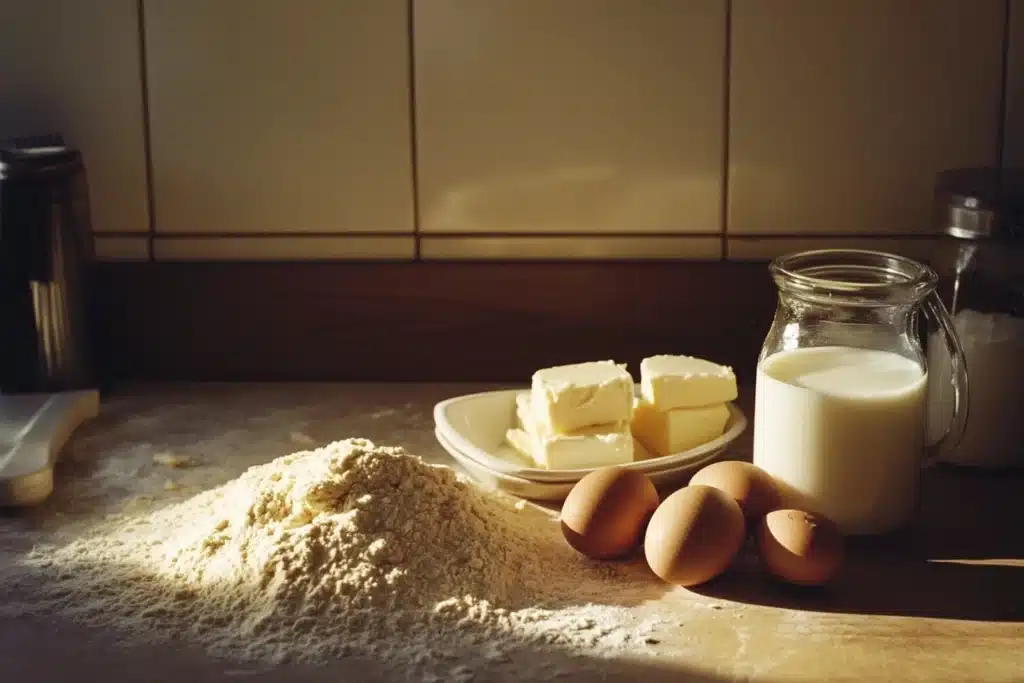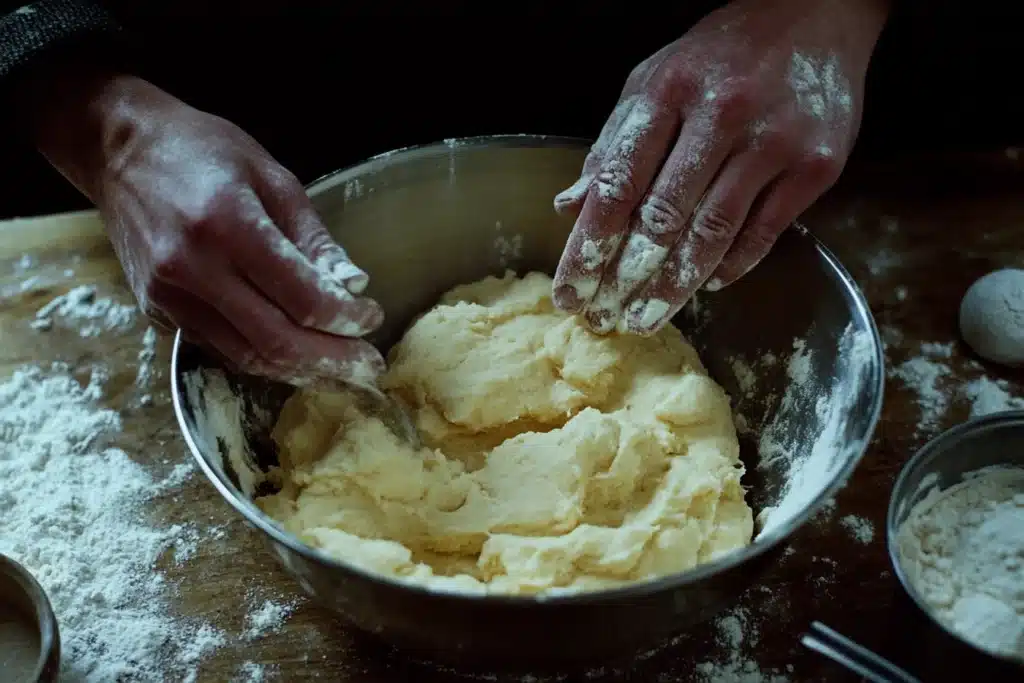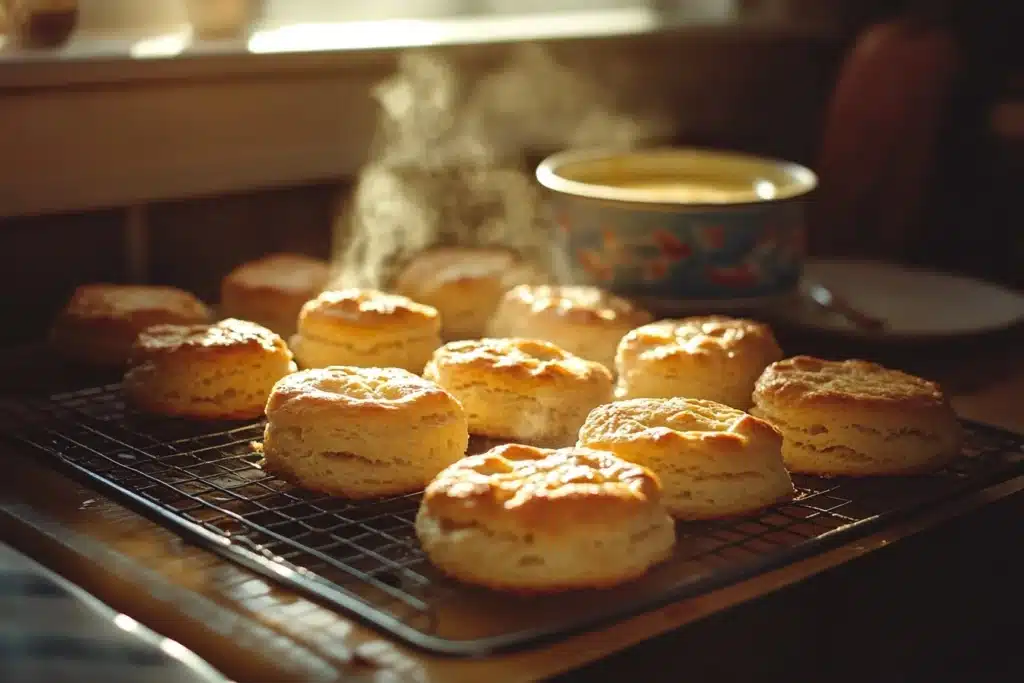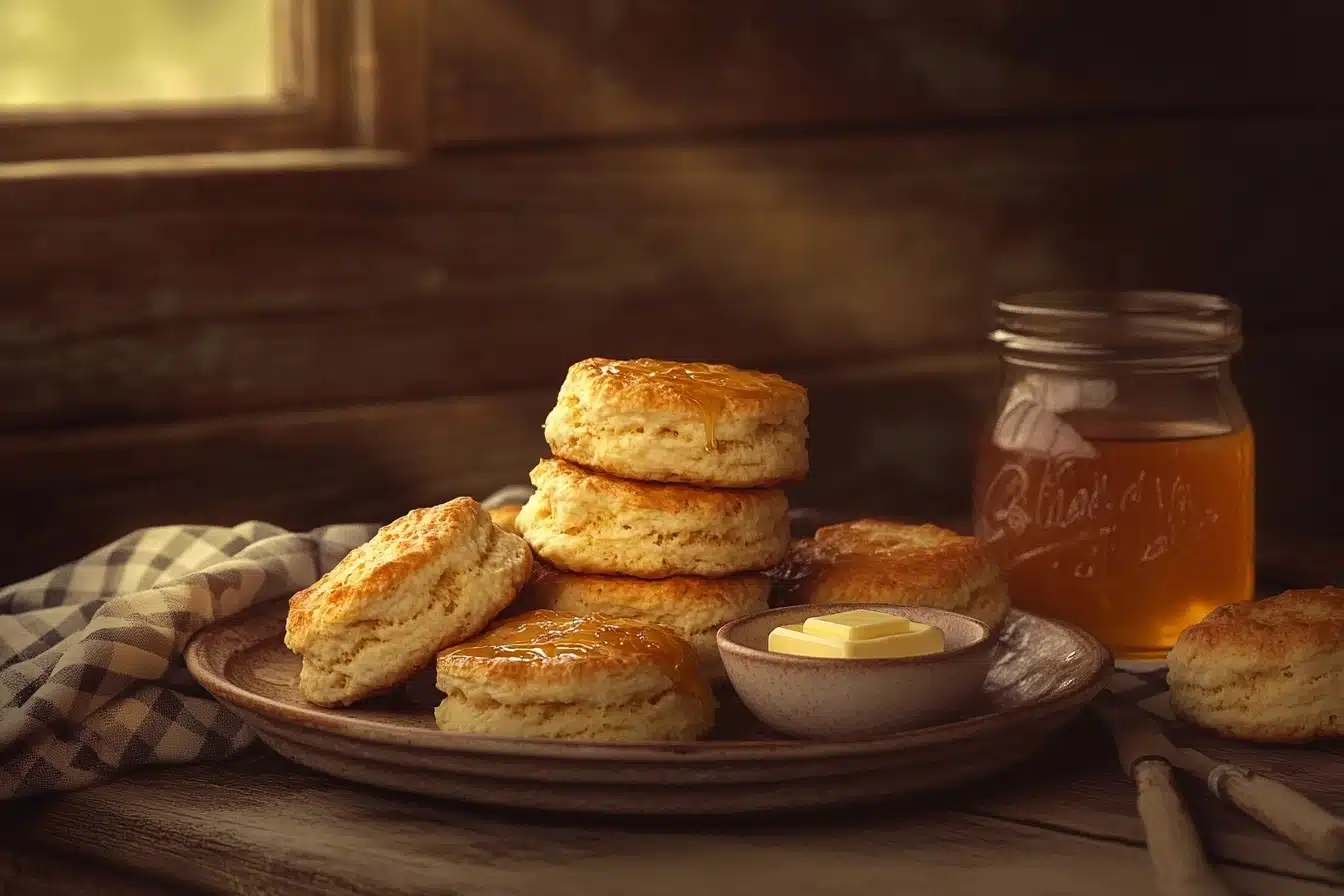Struggling with dry Bisquick biscuits can turn what should be a comforting treat into a frustrating experience. But fear not! This article unpacks everything you need to know about why your biscuits might be too dry and how to fix them. From measuring techniques to baking tips, we’ll guide you toward soft, flaky, and utterly delicious biscuits every single time.
Understanding the Basics
Common Issues with Bisquick Biscuits
Bisquick biscuits are beloved for their simplicity, but they’re not foolproof. One common issue is dryness, which can stem from missteps during preparation, baking, or ingredient selection. Dry biscuits often lack the soft, crumbly texture we crave.
Importance of Moisture in Biscuits
Moisture plays a crucial role in achieving the perfect biscuit texture. Without enough liquid, fat, or proper handling, the end result can feel more like cardboard than comfort food. Knowing what contributes to moisture loss is the first step toward making consistently fluffy biscuits.
For a comprehensive resource on creating the perfect Bisquick biscuits, including additional tips, recipe variations, and creative ideas, check out The Ultimate Guide to Perfect Bisquick Biscuits.
Composition of Bisquick Mix
Key Ingredients and Their Roles
Bisquick mix combines flour, leavening agents, salt, and shortening. Each ingredient contributes to the final product: flour provides structure, shortening adds tenderness, and leavening agents help the dough rise. When proportions go awry, biscuits can lose their delicate balance.
How Bisquick Differs from Other Baking Mixes
Unlike homemade mixes, Bisquick includes pre-blended shortening. While convenient, it can sometimes lead to dryness if other ingredients aren’t added properly. Compared to scratch-made recipes, adjustments to fat or liquid content might be necessary to perfect the texture.

Measuring Ingredients Accurately
When it comes to baking Bisquick biscuits, precision is everything. A slight misstep in measuring ingredients can make or break the recipe. If you’ve ever wondered why your biscuits are dry and crumbly, the answer might lie in your measuring cup. Using too much flour or too little liquid can strip your biscuits of their tender texture, leaving them disappointingly hard.
Effects of Too Much Flour
Adding too much flour is one of the most common culprits behind dry biscuits. It’s easy to accidentally pack flour into the measuring cup, especially if you’re scooping directly from the bag. This packs in more than needed, throwing off the balance of the recipe.
Excess flour stiffens the dough, making it harder to mix and knead. Worse yet, the biscuits won’t rise properly, and they’ll come out dense and dry. To avoid this, spoon the flour into your measuring cup lightly, then level it off with a straight edge. Remember, precision matters—eyeballing it isn’t an option when you’re striving for perfection.
Importance of Correct Liquid Ratios
The liquid-to-dry ingredient ratio is what determines your biscuit’s texture. Too little liquid creates a dry, crumbly dough that won’t bind properly, while too much can make the dough sticky and hard to handle.
When working with Bisquick, the type of liquid also matters. Milk, for example, adds richness, while water might yield a less flavorful result. Start with the recommended amount in the recipe, but be prepared to adjust slightly based on the dough’s consistency. The ideal dough should be soft and just a little sticky—not so wet that it clings to your hands, but not dry enough to crack.
Next time, with proper measuring and attention to detail, you’ll be setting yourself up for soft, moist, and delicious biscuits.
Mixing Techniques for Fixing Dry Biscuits
The way you mix your dough can dramatically affect the outcome of your biscuits. While it might seem logical to mix vigorously to achieve a smooth texture, overmixed biscuit dough is one of the most common reasons for dry Bisquick biscuits. Learning proper mixing methods is key to achieving biscuits that are soft, flaky, and perfectly moist.
Consequences of Overmixing Biscuit Dough
Overmixing is a surefire way to end up with dry and tough biscuits. When dough is overworked, the gluten in the flour develops too much, which creates a dense, chewy texture instead of the light, airy result you’re after.
This often happens when bakers stir too long, trying to eliminate every lump in the dough. However, Bisquick biscuit dough isn’t supposed to be perfectly smooth—a few lumps are entirely normal and even beneficial. Overmixed dough also becomes harder to roll and cut, further contributing to dry biscuits.
To avoid this, mix your dough only until the ingredients are just combined. Remember, the less you handle the dough, the better your biscuits will be.
Proper Mixing Methods for Moistening Bisquick Biscuits
The secret to moistening Bisquick biscuits and ensuring a tender texture lies in gentle mixing. Begin by whisking the dry ingredients, like the Bisquick mix, to ensure everything is evenly distributed. Then, slowly incorporate the liquid ingredients, stirring with a fork or wooden spoon until the dough begins to come together.
Once the dough forms, stop immediately—even if there are dry spots. These will hydrate as the dough rests. For minimal handling, gently press the dough together with your hands rather than kneading. Always work on a floured surface to prevent sticking.
By following these biscuit baking tips, you’ll avoid overmixing and create dough that is soft, easy to handle, and ready to bake into biscuits that are moist, fluffy, and utterly delicious.

Dough Handling Practices
Handling biscuit dough is a delicate process that requires care and a light touch. Overhandling can lead to tough, dry biscuits, while a gentle approach preserves the soft, flaky texture you’re aiming for. The way you treat the dough after mixing is just as important as the ingredients themselves.
Impact of Overworking the Dough
Overworking biscuit dough compresses it, activating the gluten in the flour excessively. This creates a dense structure that results in biscuits that are heavy, chewy, and dry instead of light and airy.
The problem often starts with rolling and kneading. Some bakers mistakenly think that more kneading equals better biscuits, but with Bisquick, this couldn’t be further from the truth. Excessive pressing and folding can also squeeze out the air pockets that help the dough rise during baking.
To avoid overworking, handle the dough as little as possible once it comes together. Remember, biscuit dough is not bread dough—it doesn’t need intense kneading to develop structure.
Tips for Gentle Dough Handling
When working with biscuit dough, think soft and light. Begin by turning the dough out onto a lightly floured surface. Use your hands to gently press it into shape instead of aggressively rolling or pounding it.
If you need to roll the dough, do so lightly, and aim for a uniform thickness. Avoid repeatedly folding or rerolling the scraps, as this can cause the dough to become overworked and dry. Instead, combine scraps with minimal handling and bake them as-is.
For cutting, use a sharp biscuit cutter and press straight down without twisting. Twisting seals the edges, preventing a good rise. With these tips, your dough will retain its softness and bake into perfectly moist biscuits.
Oven Temperature and Baking Time
The baking stage can make or break your biscuits. Even with perfectly mixed dough, improper oven settings or timing can lead to dry and disappointing results. Paying attention to the oven temperature and baking time is key to ensuring biscuits that are golden brown, soft, and moist.
Effects of Overbaking
Overbaking is one of the leading causes of dry biscuits. Leaving them in the oven just a few minutes too long can strip away their moisture, turning what should be tender and flaky into something hard and crumbly.
The edges of the biscuits are often the first to dry out, followed by the center. If your biscuits are consistently coming out dry, it might be because you’re baking them too long or at too high a temperature. A good rule of thumb is to remove biscuits as soon as they are golden on top and slightly firm to the touch.
Using a timer is critical—don’t rely on guesswork. And don’t forget that biscuits will continue to cook slightly even after being removed from the oven, so it’s better to err on the side of caution.
Importance of Accurate Oven Temperature
An inaccurate oven temperature can sabotage your biscuits before they even start baking. If the oven is too hot, the biscuits may cook too quickly on the outside while remaining undercooked inside. On the other hand, a low temperature might result in biscuits that take too long to bake, losing moisture in the process.
To avoid this, invest in an oven thermometer to double-check your temperature settings. Most biscuits bake best at 425°F (220°C), but every oven is different. Preheating is equally crucial—never put biscuit dough into a cold or partially heated oven.
By keeping your oven calibrated and monitoring the time closely, you can say goodbye to dry biscuits and hello to consistently moist and fluffy results.

Role of Fat in Fixing Dry Bisquick Biscuits
Fat is a crucial ingredient in preventing dry Bisquick biscuits. It contributes to softness, flakiness, and that deliciously moist texture everyone loves. While Bisquick mix includes shortening, adding extra fats like butter, lard, or cream can improve both flavor and moisture when used thoughtfully. The type of fat and its quantity directly influence the final texture and taste of your biscuits.
Choosing the Right Type of Fat to Prevent Dry Biscuits
Not all fats are created equal, especially when it comes to avoiding dry and crumbly biscuits. Butter is a favorite for its rich flavor, but because it contains water, it can sometimes make the dough a little sticky. Shortening, on the other hand, is pure fat and yields tender biscuits but lacks the depth of flavor butter provides.
To better understand the differences between various fats and their nutritional impact, check out this helpful resource on fat types and their benefits. With the right fat choice, you’ll enhance both the texture and flavor of your biscuits while keeping them moist and tender.
Lard is another excellent option. It delivers incredibly flaky biscuits with a slightly savory note, perfect for pairing with sweet or savory toppings. If you’re considering margarine or plant-based fats, keep in mind that these alternatives can alter the texture and may require adjustments to the liquid content.
To ensure flakiness, always use cold fat. Cold butter or shortening creates pockets of steam during baking, which helps the biscuits rise and stay moist. Warm or melted fat can lead to greasy, dry biscuits instead of the tender, flaky ones you desire.
Adjusting Fat Quantities for Moistening Bisquick Biscuits
When tackling dry Bisquick biscuits, a slight increase in fat can make a big difference. Adding one to two tablespoons of extra butter, cream, or shortening to your Bisquick mix can lock in moisture and create a softer texture.
If the dough feels too dry or crumbly, it’s a clear sign that more fat is needed. However, moderation is key. Overloading the dough with fat can weigh it down, resulting in dense, heavy biscuits rather than fluffy ones.
Understanding the role of fat and making thoughtful adjustments will allow you to bake biscuits that are consistently moist, tender, and full of flavor. Say goodbye to dry biscuits with these simple yet effective biscuit baking tips!
Alternative Liquid Ingredients
The liquid you choose for your Bisquick biscuits can have a significant effect on their moisture and flavor. While water or milk are the most commonly used, swapping them for richer liquids like buttermilk, yogurt, cream, or sour cream can make a world of difference. These ingredients not only add moisture but also enhance the biscuit’s texture and taste.
Using Buttermilk or Yogurt
Buttermilk is a favorite among biscuit enthusiasts for its tangy flavor and ability to produce moist, tender biscuits. Its acidity reacts with the leavening agents in Bisquick, creating an airy texture while keeping the dough soft. If you’re aiming for a traditional Southern-style biscuit, buttermilk is an excellent choice.
Yogurt, particularly plain or Greek, is another fantastic alternative. It offers a similar tangy flavor and richness as buttermilk while adding a touch of creaminess. When using yogurt, you may need to thin it slightly with water or milk to match the consistency of buttermilk. Both options provide a boost in moisture without making the dough sticky or hard to handle.
Incorporating Cream or Sour Cream
Heavy cream is another excellent liquid option for Bisquick biscuits. Its high fat content not only adds moisture but also contributes to a velvety texture and indulgent flavor. Biscuits made with cream tend to be richer and slightly denser, making them perfect for a luxurious treat.
Sour cream works similarly, adding both moisture and a subtle tang. Its thicker consistency requires you to combine it with a splash of milk or water to prevent the dough from becoming too heavy. Sour cream biscuits are wonderfully soft and flavorful, ideal for pairing with sweet or savory toppings.
By experimenting with these alternative liquids, you can elevate the moisture and taste of your biscuits, ensuring they come out perfectly every time.
Frequently Asked Questions
Why Did My Bisquick Biscuits Turn Out Dry?
If you’ve been wondering, Why did my Bisquick biscuits turn out dry?, you’re not alone. Dry Bisquick biscuits are usually caused by a combination of issues, such as inaccurate ingredient measurements, overmixing the dough, or overbaking. Using too much flour, for instance, can make the dough stiff and crumbly, which leads to dry results. Similarly, adding too little liquid leaves the dough underhydrated, causing the biscuits to lack the moisture needed for softness.
Another key issue is overmixing. When you overwork the dough, the gluten in the flour becomes overdeveloped, resulting in tough and dry biscuits. Additionally, overbaking is a frequent culprit. Biscuits left in the oven even a minute or two too long will lose moisture, making them harder and drier than desired.
To avoid dry Bisquick biscuits, follow these simple tips: Always measure your ingredients accurately to prevent adding too much flour or too little liquid. When mixing, stop as soon as the dough is combined—Bisquick biscuits should remain slightly lumpy. Finally, pay close attention to baking time and temperature. Remove your biscuits from the oven as soon as the tops turn golden brown.
By addressing these factors, you can eliminate dryness and enjoy consistently soft, fluffy, and moist Bisquick biscuits.
How to Make Bisquick Biscuits with Sour Cream
To make Bisquick biscuits with sour cream, simply replace some or all of the liquid (such as milk or water) with sour cream. Start with the standard recipe and add ½ cup of sour cream for every 2 cups of Bisquick mix. The sour cream adds moisture and a tangy richness that enhances the biscuit’s flavor and texture. If the dough feels too thick, thin it slightly with a tablespoon of milk or water. Be sure to mix gently to avoid overworking the dough. Bake as directed for soft, fluffy biscuits with a unique, creamy flavor.
How to Sweeten Bisquick Biscuits
To sweeten Bisquick biscuits, you can add sugar, honey, or maple syrup to the dough before baking. For a subtle sweetness, stir in 2–3 tablespoons of sugar per 2 cups of Bisquick mix. If you prefer a richer, natural flavor, swap the sugar for 2 tablespoons of honey or maple syrup. Adding a pinch of vanilla extract can also enhance the sweetness. Once baked, consider brushing the biscuits with melted butter and sprinkling sugar or cinnamon on top for an extra sweet touch.
How to Make Bisquick Biscuits Taste Sweeter
For a sweeter taste, mix in sweet ingredients like chocolate chips, dried fruits (raisins or cranberries), or even a little cinnamon and sugar. You can also serve the biscuits with sweet toppings like honey butter, fruit preserves, or whipped cream. For a dessert-style biscuit, drizzle with a glaze made of powdered sugar and milk. Adjusting the sweetness within the dough and adding flavorful toppings will easily turn ordinary Bisquick biscuits into a treat!
Looking to add a touch of sweetness to your biscuits? Check out How to Sweeten Bisquick Biscuits: Easy Tips and Delicious Recipes for simple techniques and creative ideas.
How to Make Bisquick Biscuits Fluffy
To make fluffy Bisquick biscuits, ensure you measure your ingredients correctly and avoid overmixing the dough. Use buttermilk or sour cream instead of water or regular milk for added richness. Cold fat, such as butter or shortening, is key to creating steam pockets that result in fluffiness—keep it chilled until mixing. Gently pat the dough and cut biscuits with a sharp cutter, pressing straight down to prevent sealing the edges. Bake in a fully preheated oven at the recommended temperature to achieve the best rise.If you’re interested in using sour cream to create moist and flavorful biscuits, don’t miss How to Make Bisquick Biscuits with Sour Cream: A Step-by-Step Guide.
Is Bisquick Better with Water or Milk?
Milk is generally better than water when making Bisquick biscuits. Milk adds flavor, creaminess, and richness that water cannot provide. The natural fats in milk contribute to a softer texture and more tender biscuit. If water is your only option, consider adding a tablespoon of melted butter or a splash of cream to improve the biscuit’s taste and texture. For the best results, opt for milk or a milk substitute like almond milk or buttermilk. Curious about whether water or milk works best for Bisquick biscuits? Discover the pros and cons in Is Bisquick Better with Water or Milk? A Comprehensive Guide.
How do I keep Bisquick biscuits from being dry?
To prevent dryness, avoid overmixing the dough, and don’t skimp on the liquid. Using richer liquids like buttermilk or adding ingredients like sour cream or cheese can also help retain moisture. Additionally, baking for too long can dry out the biscuits, so check them a few minutes before the recommended time.
Want more detailed expert advice? Check out How to Keep Bisquick Biscuits from Being Dry: Expert Tips for additional insights.
Why are my homemade biscuits so dry?
Dry biscuits often result from using too much flour (or Bisquick mix) relative to the liquid. Measure your ingredients carefully and aim for a soft, slightly sticky dough. Handling the dough too much can also lead to dryness, so mix and knead as little as possible.
For a deeper dive into the causes and solutions, visit Why Are My Homemade Biscuits So Dry? Causes and Fixes.
What should I do if biscuit dough is too dry?
If your dough feels dry or crumbly, don’t panic. Simply add a tablespoon of milk or water at a time until the dough comes together. It’s better to err on the side of a slightly wetter dough, as this will help produce moist, tender biscuits.
For more step-by-step solutions, check out What to Do if Biscuit Dough Is Too Dry: Ultimate Guide.
What to do if biscuit dough is too dry?
If your biscuit dough feels too dry, add more liquid one tablespoon at a time until the dough comes together. Use milk, buttermilk, or even water to hydrate the dough. Be cautious not to overwork the dough while mixing, as this can make the biscuits tough. Letting the dough rest for a few minutes can also help the flour absorb the added liquid, creating a softer texture.
For more step-by-step solutions, check out What to Do if Biscuit Dough Is Too Dry: Ultimate Guide.
How can I make my biscuits more moist?
To make your Bisquick biscuits moist, try increasing the liquid slightly or incorporating richer alternatives like buttermilk, yogurt, or sour cream. Adding a tablespoon of extra fat, such as butter or shortening, can also help retain moisture. Including cheese, grated vegetables, or fruits in the dough introduces additional moisture and flavor. Finally, avoid overbaking by keeping a close eye on them and removing them from the oven as soon as they’re done.
Is it better to use milk or water in Bisquick biscuits?
Milk is generally a better choice than water for Bisquick biscuits because it adds creaminess, richness, and flavor. The natural fats and proteins in milk contribute to a softer texture and improved moisture. Water, while functional, lacks these qualities, which can result in biscuits that are drier and less flavorful. If milk isn’t an option, try using plant-based milk alternatives or adding a touch of cream to compensate for the difference.
Can overmixing really make biscuits dry?
Yes, overmixing can make biscuits dry and tough. Vigorous mixing develops too much gluten in the flour, which can result in a chewy, dense texture. Bisquick dough should be mixed just until the ingredients are combined, leaving a slightly lumpy texture. Overworking the dough during rolling or shaping can also contribute to dryness. For tender, flaky biscuits, handle the dough minimally and mix with a light hand.
Conclusion
Recap of Key Points
Dry Bisquick biscuits can result from several factors, including too much flour, improper liquid ratios, overmixing, or overbaking. Accurate measuring, gentle mixing, and the right baking techniques are crucial for achieving soft, moist, and fluffy biscuits. Using alternative liquids like buttermilk or sour cream and incorporating moisture-rich additives like cheese, vegetables, or fruits can also improve your results. Additionally, maintaining the correct oven temperature and choosing the right type of fat ensures a tender and flavorful outcome every time.
Encouragement for Future Baking
Baking the perfect Bisquick biscuits might seem tricky at first, but with patience and a few adjustments, you’ll be turning out tender, moist biscuits in no time. Don’t be afraid to experiment with different ingredients, from sour cream to fruits, to create a flavor that’s uniquely yours. Remember, baking is a learning process, and each attempt brings you closer to mastery. With these tips in mind, you’re well on your way to making biscuits that everyone will rave about. Now, grab that Bisquick mix and start baking—you’ve got this!

